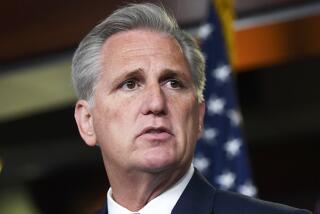How bad will it get without a bailout?
- Share via
WASHINGTON — If the House vote against the $700-billion financial rescue proposal stands, Americans may be in for a test of free-market economics the likes of which the country hasn’t seen since the early 1930s.
With the Treasury Department hobbled by the rejection of its plan, the Federal Reserve and Federal Deposit Insurance Corp. are the chief government institutions standing between the nation and the brutally Darwinian process that could unfold if the panicky financial markets are left to sort their problems out alone.
It’s an open question whether those two institutions acting alone have the resources and power to avert such a debacle -- the cascading failure of hundreds, perhaps thousands, of financial institutions and paralysis spreading across the whole economy.
“We’re entering a new phase of the crisis,” said Chris Rupkey, chief financial economist with the Bank of Tokyo-Mitsubishi in New York. “If you don’t stop the domino effect, you’re going to see one institution after another after another going down,” he predicted.
That’s something the United States last experienced in the early 1930s, when Herbert Hoover was in the White House. Some conservatives believe that’s still the best long-term solution to the problem, though none has gone so far as Hoover’s Treasury secretary, Andrew Mellon, who said: “Liquidate labor, liquidate stocks, liquidate the farmers, liquidate real estate. . . . It will purge the rottenness out of the system.”
But House members and their supporters who insisted Monday that the government had no business staging a massive intervention in the financial marketplace were essentially making a modern-day argument for the laissez-faire economic policies of the Mellon era.
For now, the Fed and FDIC are doing what they can.
Early Monday, the Fed pumped an extra $630 billion into banks around the world. Its goal: to keep money flowing through the financial plumbing that’s hidden from view but is crucial to the global economy’s operation.
Meanwhile, the FDIC, for the second time in a week, orchestrated the safe demise of a major bank, this time helping engineer the sale of Wachovia Corp., the nation’s fourth-largest bank by assets, to Citigroup Inc.
The deal puts Washington on the hook if losses in Wachovia’s $312-billion loan portfolio top $42 billion.
But the two government agencies are severely limited in what they can do to keep the crisis from affecting ordinary Americans.
For the Fed, the problem is that with business confidence so shaken, the banks on the receiving end of its latest flood of cash are parking the money in their vaults rather than lending it out to keep the economy functioning. Bankers worry that they might need the money if conditions keep getting worse.
“They won’t even lend it to each other,” said Brookings Institution economist Robert E. Litan, “and if they’re not going to lend it to each other, they certainly aren’t going to lend it to you and me.”
The lending drought means that people are having a harder time borrowing to buy houses, cars and appliances, and business are having a harder time generating sales.
Little cash is available for growth and job creation. But there’s a more immediate danger: To an extent little appreciated by most Americans, businesses today no longer pay for their day-to-day operations with their own money but do so with borrowed funds.
Making next week’s payroll or buying the supplies workers need to do their jobs tomorrow depend on loans. Without those loans, companies and the economy as a whole begin to grind to a halt.
The slowdown is feeding other problems that plague the nation: plunging home prices, the imploding value of mortgage securities and collapsing confidence. Among other things, that’s all but certain to push more financial firms over the edge.
When that happens, the Fed and the FDIC have only one course of action: to pick and choose among collapsing firms, deciding which ones get a soft landing and which ones crash.
And the ad-hoc rescue efforts create damaging ripples of their own.
“It’s very difficult for the market to know how to react when each government intervention is different,” complained Jaret Seiberg, a financial services analyst with Stanford Group. “There’s no rhyme or reason, and that leads to more market instability.”
There’s another problem with leaving the solution to the financial crisis to the Fed and the FDIC: Though they have yet to reach it, each probably has a limit to its capacity to make rescues.
For the Fed, the constraint is not the central bank’s ability to pump out cash, which is essentially limitless. Instead, it’s the quantity of the risky securities of troubled financial firms it can take on its books -- as collateral for the loans it makes to the firms -- without weakening its own financial condition.
Since the beginning of the year, Fed records show that the proportion of outside securities on the central bank’s books has climbed to about 60%, while the fraction of risk-free U.S. Treasury securities among its assets has dropped from 90% to 40%.
Fed officials assert that the change doesn’t limit the central bank’s ability to act, but outside analysts such as Brookings economist Litan are not so sure. “The Fed is looking more and more like any other private financial institution,” he said.
In the case of the FDIC, the limit is the size of the fund that insures bank deposits. The fund had $45.2 billion as of June 30, raised from premiums paid by banks. The FDIC plans to increase those premiums, although it’s unclear that the rise will be substantial, given the current crisis. In addition, it can borrow up to $30 billion from the Treasury.
If Washington’s rescue resources were to run out, the nation’s investors, traders and lenders could discover that it was up to them alone to right the financial system.
That’s a situation that has not occurred in more than three-quarters of a century, during the Great Depression.
“This is smacking more and more of the late 1920s and early 1930s,” said New York University economic historian Richard Sylla.
In fact, in a less disastrous manner than during the Depression, something like Mellon’s prescription of across-the-board liquidation is now underway.
And without a big, new program like the one rejected by the House on Monday, there is only so much the existing institutions can do.
The FDIC’s scope is limited. And, Rupkey said, “the Fed’s balance sheet is about to explode.”
--
More to Read
Inside the business of entertainment
The Wide Shot brings you news, analysis and insights on everything from streaming wars to production — and what it all means for the future.
You may occasionally receive promotional content from the Los Angeles Times.











